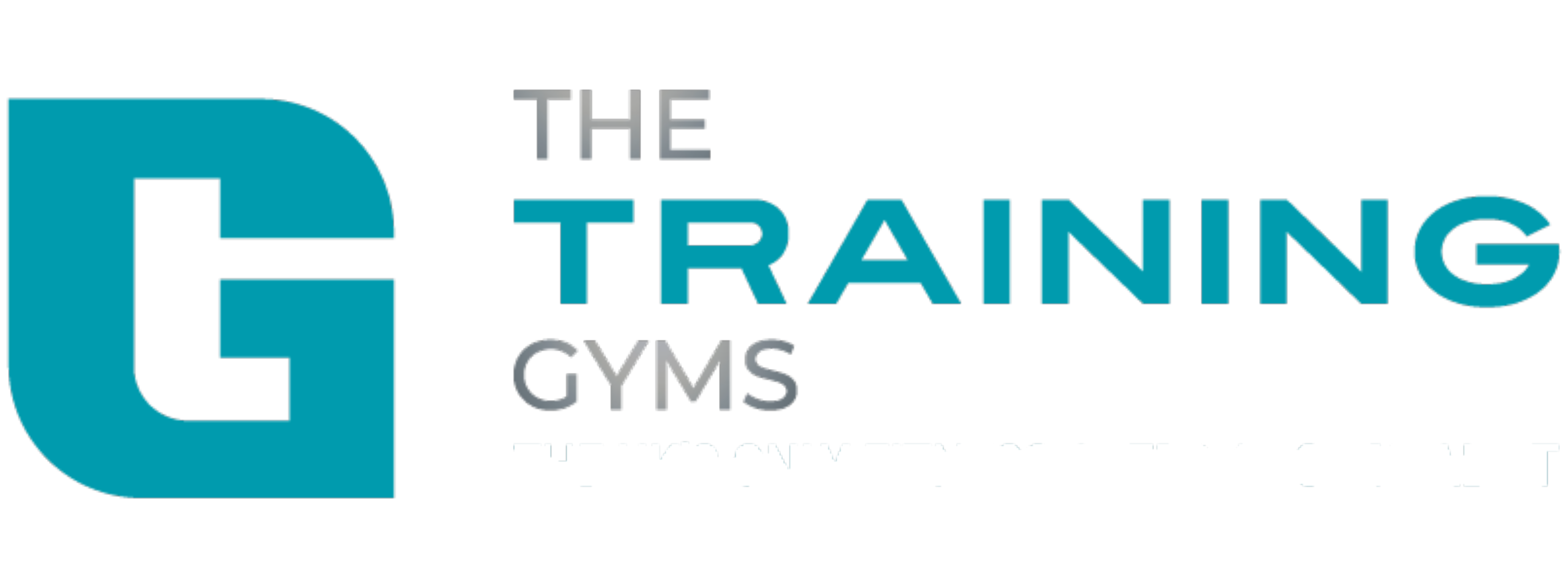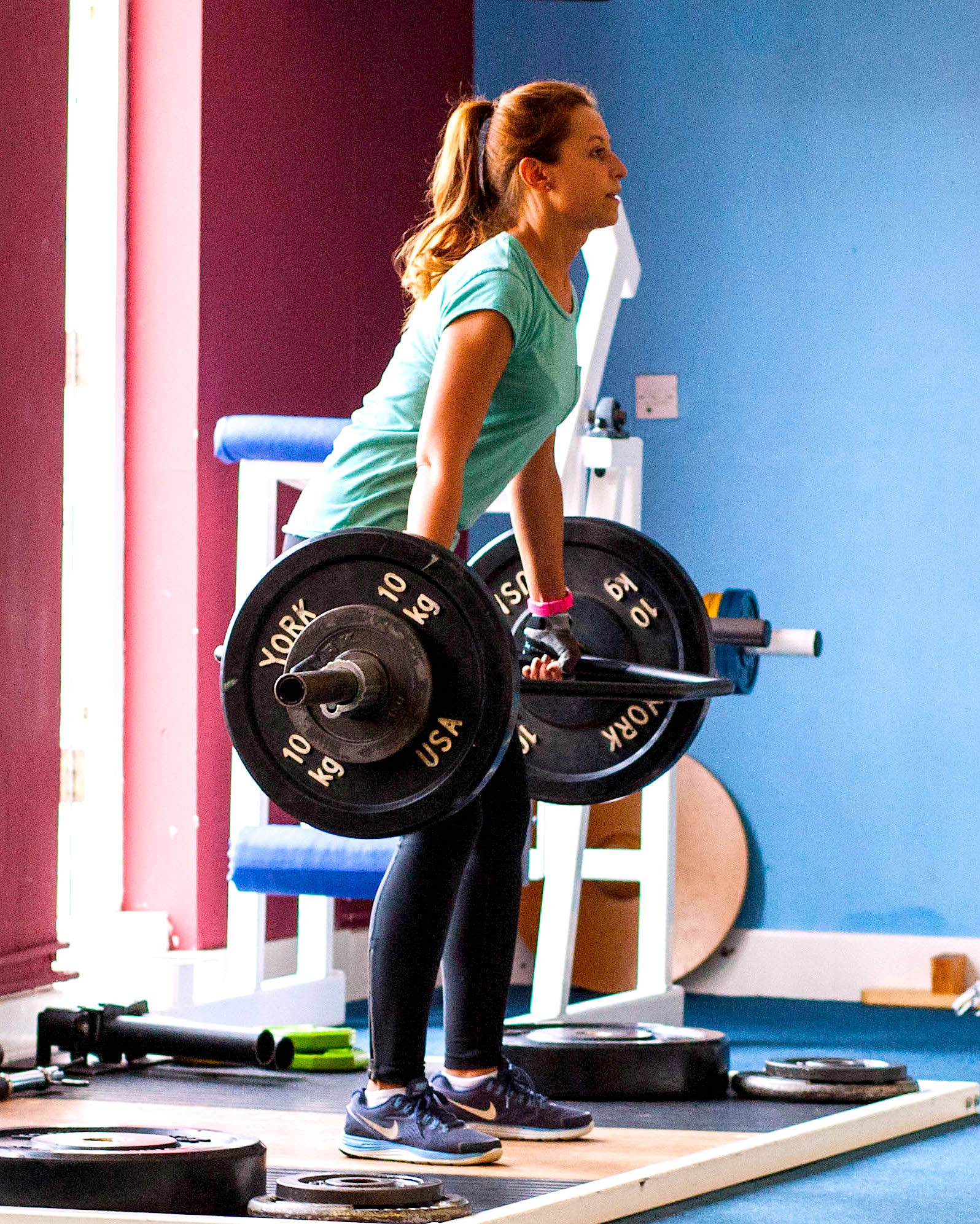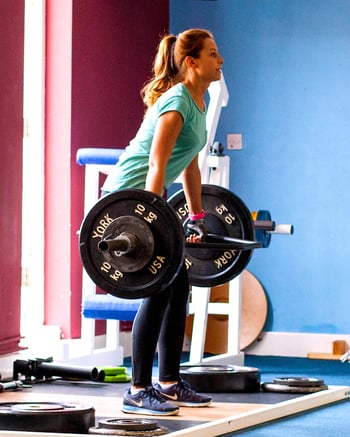
Christina: This is Christina with the DVCC and today I’m joined with Sam, trainer at the DVCC’s Bedford location. We’re going to discuss the best ways to work out for long term muscle growth.
Sam, as a personal trainer, I’m sure you have many people asking you this, but, is it possible to build muscles quickly?
Sam: Well, as a beginner, you will make the fastest gains and strength increase and put on the most muscle in the first year. However, to build a solid foundation, it does take a lot longer than most people think.
I think that’s why people give up quickly as well; people start the gym, they’ll train for maybe one to two weeks, expecting to see good gains, good results, very quickly. Often it’s not the case and then they’ll get de-motivated by not being consistent and then they’ll leave the gym and leave it there.
Christina: Because people want to see results fast?
Sam: Exactly, yes; people always want to see results in the first month or wanting to lose 3 stone within a couple of months; setting themselves unrealistic goals. I think that’s where most people go wrong to begin with.
Christina: So really it’s a long term strategy then?
Sam: It is yes, definitely. It’s something you need to create short term, medium and long term goals for the future for yourself, just to keep yourself motivated throughout the whole year.
Christina: I suppose it can be a bit de-motivating like you said, if you don’t see any results and then it’s one year away until you set your first goal.
Sam: Exactly yes, correct.
Christina: If people are trying to build muscles too fast, can they expect to get any problems; are there any problems with trying to put on the muscles quickly?
Sam: I think over-training could be one; so if people come into the gym – don’t get me wrong, training frequently is very good, but if you push yourself too far to begin with, you can over-train and that can lead to injuries further down the line.
I think people also lose motivation quickly when they don’t get the results they expected, because building muscle obviously doesn’t happen overnight, it’s a long term process.
So it’s important to keep yourself motivated, set goals like I said, and try not to over-train; have rest days to break the weeks up. Just train smart really, to begin with, nice and light and build it up from there.
Christina: And that’s, for example, somebody starting from scratch. Somebody that is used to being in the gym, do they still need to take rest days?
Sam: Exactly, yes, especially if you’re starting from scratch your body won’t be used to the weights, you want to take it nice and easy first; start with the lightest weight possible that you can control with good form. Then from there, every week, possibly increase the weight by the smallest increment and build up from there nice and slow.
Christina: One thing I’ve always had a doubt about; is it better to work with a light weight and do more repetitions or is it better to work with a heavier weight and do less?
Sam: It depends what your goals are really. Heavier weights, less reps, usually is aimed at the people who want to build strength; so what you do is you aim for maybe 1 to 5 repetitions, heavy weights and go for longer rest periods in between sets.
That’s generally aimed at strength training. For more muscle building or endurance you’d increase the rep range to something higher.
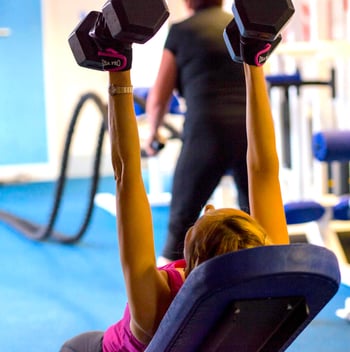 So I’d recommend, for beginners, maybe to start with 12 to 15 reps, nice and light, build a foundation first. And then after a few months, once they’ve built that foundation they can work on increasing their strength and changing up their rep ranges.
So I’d recommend, for beginners, maybe to start with 12 to 15 reps, nice and light, build a foundation first. And then after a few months, once they’ve built that foundation they can work on increasing their strength and changing up their rep ranges.
Christina: Ok. I think we’ve covered my next question; I was going to ask are there any common mistakes that people make when trying to build muscles?
Sam: I think not researching for themselves the correct way to do things; for example, having a sound nutrition plan and exercise programme to follow.
Not being consistent with their goals, with their nutrition and training; and also not using progressive overload.
Progressive overload is basically, to get bigger and stronger you need to lift more weight and add more volume, which does sound simple but there are plenty of people who train for years and don’t see any improvement and 9 times out of 10, the overload principle was violated on their behalf. So definitely look to increase your strength as frequently as you can.
Christina: So you mean, for example, people go and they lift exactly the same weight in the same way each time they go?
Sam: Exactly, never really pushing themselves to the next step, always stuck on the same weight. To build more muscle, you obviously need to increase the weight and get stronger. People get stuck in a rut there and they need to take a look at their training programme.
Christina: So what’s the healthiest way to build muscles that will last for long term?
Sam: I think, if you’re a complete beginner then you need to get yourself on a decent beginner hypertrophy routine to a muscle building programme. There are loads of programmes out there, there’s a push-pull legs, full body routine; all these routines are very good, providing you’re consistent with them.
And just make sure you’re getting stronger on all of the lifts, so every week, especially as a beginner, try to increase your strength by a certain amount is definitely the way to go, long term.
Christina: So basically, as you said, step by step with small goals and then that works for the long term as well. Do you have many women that like to build muscles, or is it mostly men?
Sam: You do get women building muscle. The thing is, the training is never any different, they should follow the same training as men. My girlfriend, for instance, does the exact same training as I do; I do an upper body, lower body split, where 2 days a week I train upper body and then 2 days a week I train lower body, with a rest day in between. And that’s all focused around muscle building.
I think women are mainly scared of putting on big muscles and getting too big; that’s never normally the case. Their testosterone levels are a lot lower than men’s, so for women to actually build any serious muscle, it’s very difficult for them to do that.
Christina: So their goal would be more to be toned?
Sam: Exactly, yes. That’s fine; if they wanted to be toned they could follow a simple full body routine or an upper body, lower body split; definitely weight train, I would definitely recommend that.
I think a lot of women make the mistake of joining a gym and just doing hours of cardio, for 30-60 minutes every day; it’s just not going to get the same results or shape the body, as weightlifting would.
Christina: If you’re weightlifting, do you need to do cardio as well or can you just do the weight training?
Sam: Depending on your goals; if you’re trying to lose body fat it’s obviously good to throw in some cardio. If you’re looking to build muscle, put on size, put on weight, I’d still definitely always recommend doing some form of cardio, whether it’s a couple of days of interval training or a couple of days of slow steady states: 30-40 minutes of low impact cardio. But it’s healthy for the heart so I’d definitely recommend you have some form of cardio in your routine.
Christina: And what kind of a diet do people need, especially people looking to build muscles, do they need to follow any special kind of diet?
Sam: In terms of nutrition, I would recommend high protein, definitely; protein is the building block for building muscle, so ensuring you’ve got adequate protein in your system is definitely important.
If you’re looking to build muscle and put on weight, then you need to be eating a fair amount of food, so high protein, high carbs, a good amount of healthy fats as well, such as avocadoes, whole organic eggs, healthy peanut butter, walnuts, almonds, things like that. And for the protein, lean chicken, meat, fish, there are tons of options out there.
Christina: So a lot of meat and a lot of potatoes.
Sam: Correct
Christina: What about supplements? I know there are a lot out there; is it necessary to take supplements?
Sam: I do think supplements are necessary to a certain extent; there is a line that I like to draw. Whey protein is a great supplement to increase your protein intake for the day which, like I mentioned, is essential for building muscle.
Whey protein is derived from dairy and it’s probably the most popular supplement in the body building industry right now, there are tons of companies selling whey protein. And it’s just convenient really; it’s 1-2 scoops in some water, with a shaker, mixed up and then you’ve got 25-50 grams of protein right there; so it’s a very easy, convenient way to get your protein up for the day.
Christina: I assume that you need to be working out if you’re going to be taking this protein supplement?
Sam: Exactly, yes; protein will be ideal for after your train, post workout, when your muscles are broken down and fatigued and need to be repaired; that’s what the protein is there for, it’s going to rebuild you.
Christina: What about supplements – often there are many supplements that appear on the internet etc – are there any that should be avoided?
Sam: I think fat burners are one of them; you can get these in liquid or pill form, mainly pill form, and they are just basically caffeine pills to a certain extent. So they’ll just make you have a really big buzz and make you sweat a lot, but essentially they’re just caffeine pills loaded with a load of different additives and they can be quite unhealthy for the body.
So definitely fat burners are one of them. And I think pre-workout also is unnecessary; I think you can get a decent workout just using plain black coffee, strong coffee, maybe 30 minutes prior to training. This is usually sufficient to give you a bit of a buzz through the workout and keep you going enough. So those two I would say could be avoided.
Christina: Who is the best person to ask about that; can people ask you about supplements as a personal trainer or do you need to consult with a doctor?
Sam: I think as long as you haven’t got any allergies, most personal trainers should know the basics of whey protein, fat burners and supplements like that. So personal trainers would be your best option.
Christina: What about time involved in muscle training? Do I have to spend every day in the gym to get larger muscles?
Sam: You do not; I think that’s what deters a lot of people from exercising; you can get great results – we recommend here at the DVCC, the minimum requirement would be 45 minutes, 3 days a week. So you could do, for instance, on non consecutive days, Monday, Wednesday, Friday.
You could do a 30 minute session up here with us, followed by 15 minutes of a ‘Fat Loss 15’, which is basically interval training on the rowers. So every week we change the intervals; this week it’s 30 seconds rowing as fast as you can, followed by a 30 second rest period, and then repeat that 10 times. So 45 minutes, 3 days a week, with a sound nutrition plan, is enough to see results.
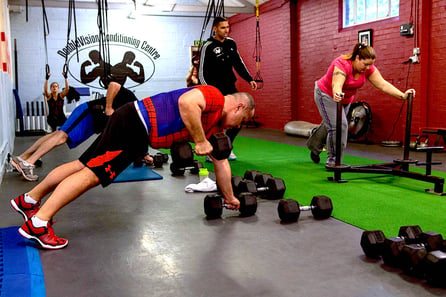 Christina: That’s interesting; I’ve always thought of cardio being 30 minutes of running or 30 minutes of rowing, or 30 minutes of anything; but you talk about doing it in split intervals.
Christina: That’s interesting; I’ve always thought of cardio being 30 minutes of running or 30 minutes of rowing, or 30 minutes of anything; but you talk about doing it in split intervals.
Sam: Yes, we’ve found here that interval training is superior; in terms of fat loss, it’s shorter; running on a treadmill for 45 minutes to an hour can get monotonous and a bit boring.
So the good thing about intervals is they only last maybe 10-15 minutes, so they’re over pretty quickly which will help you stay motivated.
Also, the science behind it is rowing through a very fast pace or running at a very fast pace and then you slow down, recover and repeat, it tricks your body into burning fat and you’ll burn fat for the next 24-48 hour period. People see very good results from this.
Christina: What about the cost; do I have to invest in anything special to do muscle training, any special equipment? Or is everything there at the DVCC? What would I need?
Sam: All you’d need to bring here is motivation – we’d obviously help you with that as well – you need to bring just gym equipment. So if you have comfortable clothing to wear, maybe track suit bottoms, a baggy t-shirt or a training top, and then just comfortable training shoes, that’s all you’d need; we provide the rest. So everything from all the equipment, the dumbbells, the nutritional plan, it’s all set up from the outset.
Christina: That’s excellent! Sam, why then is it important, why do people muscle train, why is it important to have strong muscles?
Sam: I think when you increase your muscle mass you change your body composition, creating a lower body fat percentage. A lower body fat percentage can translate to a reduced risk of chronic conditions such as high blood pressure, cholesterol and increased blood sugar levels.
So it’s very important for health reasons and also it’s good for motivation for yourself, for confidence I think as well – a lot of people use it for this – and it’s just fun to set yourself goals, trying to increase certain lifts and certain muscles month by month is something good to do.
Christina: What does the sample workout look like then?
Sam: At the DVCC or a general muscle building one?
Christina: At the DVCC.
Sam: We have a muscle building routine here at the moment and it would last approximately 30 minutes. The phase we’ve got at the moment, it would be two exercises and the first one would be done back to back with the second one, so for instance I would do a barbell squat followed by an incline dumbbell bench press, so you’d be working chest and legs. You would aim for maybe 10-12 repetitions on the squats and you’d go into the incline press and aim for 10-12 reps on there also.
Then you’d maybe have a short rest period and repeat. Every day is a different routine, so if you have a rest day the next day you would come back and then there would be two different kind of exercises to do, just to keep it interesting.
Christina: That’s good, so then people don’t get bored.
Sam: Exactly; I think that’s very important with training as well. Here at the DVCC, we mix up the routines and phases every four weeks; that keeps clients motivated and keeps them consistent with their training.
Christina: Yes definitely, because it can get really boring if you just do the same thing every time you go.
Sam: Yes, it can get extremely boring.
Christina: My next question was would muscle work be better accompanied by cardio and you already said yes, so what kind of cardio would be a good complement to muscle training?
Sam: Depending on how frequently you train, like I said you still should incorporate some form of cardio into your routine for overall cardiovascular health; also adding cardio will actually allow you to eat more nutrients as you’ll be burning more calories, so it’s useful for that. I think interval training is superior as it’s short and sweet and we’ve seen the best results down here; so you’d go maybe two, or maximum three, if you’re trying to build muscle, days a week high intensity interval training, so you don’t have to do this indoors.
If you need to be outside you can sprint possibly for 20 seconds, rest for however long it takes, maybe 30 seconds to a minute, and then repeat that again, maybe for 6-10 times, depending on your fitness level.
So that’s interval training. And then you could also do some low intensity training as well; you could just go out for a brisk walk, maybe for 20-30 minutes, or just do some light rowing, to get the heart rate up; this would be good for maybe 2-3 times a week.
The thing with cardio building muscle, if you’re trying to put on weight and you’re quite a lean person to begin with, adding too much cardio can set you back as it’s going to burn those calories that you need in order to put on size; so I think it’s a good idea to keep it to a minimum, if you’re trying to put on muscle.
Christina: That makes sense, because we’re not looking for weight loss here, we’re looking for muscle building.
Sam: Correct; it’s a different end of the spectrum, so approach it a little bit differently.
Christina: Of course, and I imagine that every person that goes to the DVCC goes with slightly different goals.
Sam: Exactly, yes; we’ve got different people here looking for different goals; clients that have got down to a desired body fat level, now they’re looking to put on muscle, so their routines are slightly different.
Most of our clients we’ve got the other end of the spectrum, people that are looking to lose body fat. Also, as a complete beginner, you will see some muscle growth to begin with when you start training, but it will just be a little bit different to if you’re trying to put on size on its own.
Christina: So my last question: what do you do to best motivate people? How do you keep people motivated to build stronger muscles?
Sam: I think definitely setting personal goals is very important, it helps to keep people focused on what they’re achieving; it could be anything from adding a certain amount of weight to their back squats to a certain date, or adding half an inch onto their arms, setting goals like that, trying to keep them motivated. And definitely giving them positive feedback constantly, to just congratulate them, definitely builds confidence in them and helps spur them on to keep progressing.
Christina: So there’s no naming and shaming involved, it’s more of a positive attitude?
Sam: Definitely; positivity is the number one thing, yes.
Christina: Sam, is there anything else that you’d like to add?
Sam: No, that’s pretty much it; I’d just like to add if you’re thinking about building muscle or losing fat, just remember to set small goals at a time. Also set some long term goals; be consistent with your training, be consistent with your nutrition and you’ll definitely get the results you’re looking for.
Christina: Thank you very much. The DVCC has centres in Bedford, Milton Keynes, Northampton and Hitchin – and very shortly, Stevenage and central Bedfordshire. So if you’ve been listening to this interview and you’d like to find out more about how the DVCC can help you, then please book an appointment for a DVCC Right Fit phone call at www.theDVCC.com/signup.
